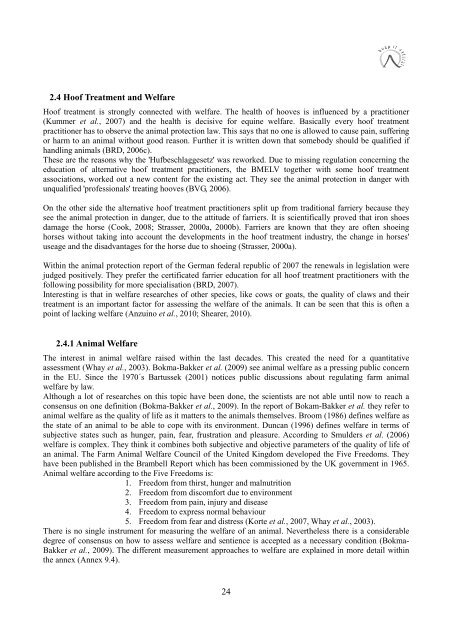Bachelor Thesis - Christina Kuenen - Hufpfleger
Bachelor Thesis - Christina Kuenen - Hufpfleger
Bachelor Thesis - Christina Kuenen - Hufpfleger
Create successful ePaper yourself
Turn your PDF publications into a flip-book with our unique Google optimized e-Paper software.
2.4 Hoof Treatment and Welfare<br />
Hoof treatment is strongly connected with welfare. The health of hooves is influenced by a practitioner<br />
(Kummer et al., 2007) and the health is decisive for equine welfare. Basically every hoof treatment<br />
practitioner has to observe the animal protection law. This says that no one is allowed to cause pain, suffering<br />
or harm to an animal without good reason. Further it is written down that somebody should be qualified if<br />
handling animals (BRD, 2006c).<br />
These are the reasons why the 'Hufbeschlaggesetz' was reworked. Due to missing regulation concerning the<br />
education of alternative hoof treatment practitioners, the BMELV together with some hoof treatment<br />
associations, worked out a new content for the existing act. They see the animal protection in danger with<br />
unqualified 'professionals' treating hooves (BVG, 2006).<br />
On the other side the alternative hoof treatment practitioners split up from traditional farriery because they<br />
see the animal protection in danger, due to the attitude of farriers. It is scientifically proved that iron shoes<br />
damage the horse (Cook, 2008; Strasser, 2000a, 2000b). Farriers are known that they are often shoeing<br />
horses without taking into account the developments in the hoof treatment industry, the change in horses'<br />
useage and the disadvantages for the horse due to shoeing (Strasser, 2000a).<br />
Within the animal protection report of the German federal republic of 2007 the renewals in legislation were<br />
judged positively. They prefer the certificated farrier education for all hoof treatment practitioners with the<br />
following possibility for more specialisation (BRD, 2007).<br />
Interesting is that in welfare researches of other species, like cows or goats, the quality of claws and their<br />
treatment is an important factor for assessing the welfare of the animals. It can be seen that this is often a<br />
point of lacking welfare (Anzuino et al., 2010; Shearer, 2010).<br />
2.4.1 Animal Welfare<br />
The interest in animal welfare raised within the last decades. This created the need for a quantitative<br />
assessment (Whay et al., 2003). Bokma-Bakker et al. (2009) see animal welfare as a pressing public concern<br />
in the EU. Since the 1970´s Bartussek (2001) notices public discussions about regulating farm animal<br />
welfare by law.<br />
Although a lot of researches on this topic have been done, the scientists are not able until now to reach a<br />
consensus on one definition (Bokma-Bakker et al., 2009). In the report of Bokam-Bakker et al. they refer to<br />
animal welfare as the quality of life as it matters to the animals themselves. Broom (1986) defines welfare as<br />
the state of an animal to be able to cope with its environment. Duncan (1996) defines welfare in terms of<br />
subjective states such as hunger, pain, fear, frustration and pleasure. According to Smulders et al. (2006)<br />
welfare is complex. They think it combines both subjective and objective parameters of the quality of life of<br />
an animal. The Farm Animal Welfare Council of the United Kingdom developed the Five Freedoms. They<br />
have been published in the Brambell Report which has been commissioned by the UK government in 1965.<br />
Animal welfare according to the Five Freedoms is:<br />
1. Freedom from thirst, hunger and malnutrition<br />
2. Freedom from discomfort due to environment<br />
3. Freedom from pain, injury and disease<br />
4. Freedom to express normal behaviour<br />
5. Freedom from fear and distress (Korte et al., 2007, Whay et al., 2003).<br />
There is no single instrument for measuring the welfare of an animal. Nevertheless there is a considerable<br />
degree of consensus on how to assess welfare and sentience is accepted as a necessary condition (Bokma-<br />
Bakker et al., 2009). The different measurement approaches to welfare are explained in more detail within<br />
the annex (Annex 9.4).<br />
24


